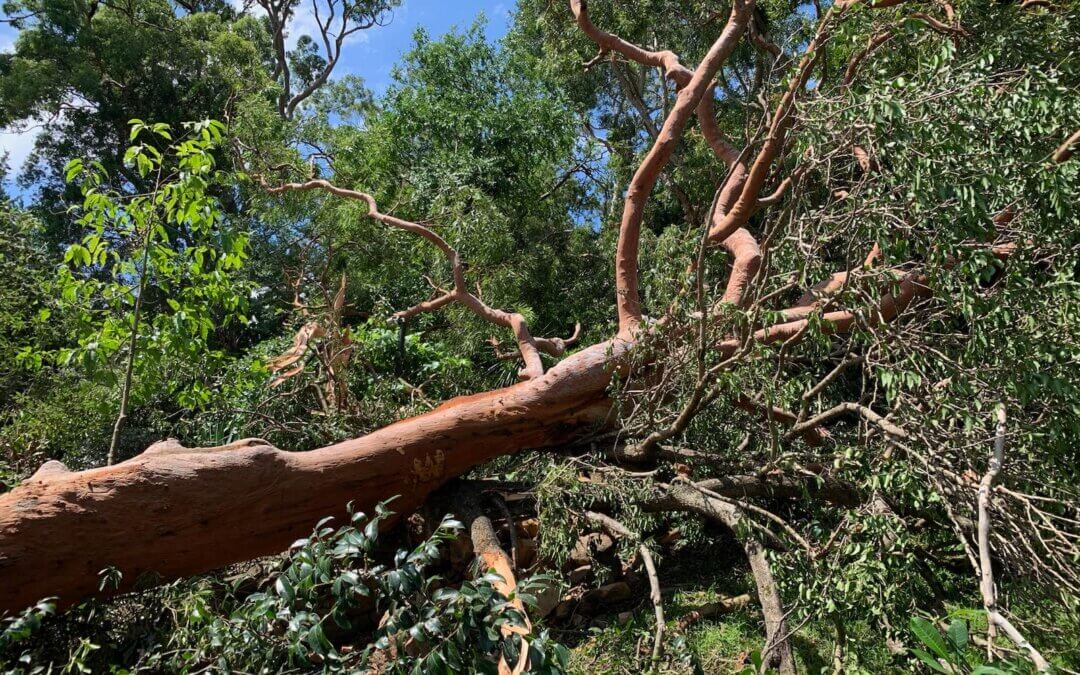Towering Angophora trees and other large tree species commonly found on the Northern Beaches and North Shore of Sydney can bring beauty and shade. Whilst they may just fall on your mother-in-law, they can also present a high risk to people and property.
Here are ten crucial signs to watch for.
Damaged or Broken Branches
A hanging, broken, or damaged branch is a clear red flag, especially when it’s large enough to pose a threat to people or property. The sheer weight of the wood can be very deceptive, underestimating its destructive potential.
Don’t hesitate to seek advice from a professional arborist and remove the branch if it’s deemed a risk.
Dead Branches
Dead branches are easy to spot, particularly during spring and summer when trees should be lush with green leaves. Look for branches with brown, withered leaves or none at all. Over time, these branches may shed their bark, becoming brittle and fragile, making them susceptible to falling even on calm days.
If your tree hosts dead branches within its canopy, consider their size, weight, and position. If they could endanger people or property, engage an arborist to remove them safely.
Removal of these branches can also increase the visual appeal of the tree.
Bracket (or shelf) Fungi
Fungi, with their root system known as mycelium, infiltrate the wood’s vertical vascular system, breaking down fibres and inducing rot.
These fungi target a living tree’s heartwood, causing extensive rot both above and below their presence. Over time, this can lead to the tree hollowing out, jeopardizing its structural integrity. This may necessitate significant pruning or even complete removal.
The internal wood can become so soft it’s comparable to a sponge – with little to no ability to support any significant weight.
Unfortunately, there is currently no known method to halt the fungal growth. By the time you become aware of its presence, it has likely been silently affecting the tree for many years. Even if you remove the external fruiting bracket, spores remain inside the tree, continuing the decomposition process.
Weight reduction pruning on infected branches can alleviate stress on weak areas. However, for a permanent solution, complete tree removal is often necessary.

Poor Structure
Recognizing an unsafe tree isn’t always straightforward. Picture a tree with a slender trunk that erupts into a magnificent canopy of thick, long branches and a profusion of leaves. While it may seem healthy, appearances can deceive.
Certain tree species, such as heavy gum trees, may grow close together, competing for sunlight, and develop tall, narrow trunks. This can make them prone to splitting or falling due to their own weight.
Skilful pruning during their early years can help prevent this problem.
Leaf Loss
Leaf loss outside of the usual season is cause for concern. Thin, dry, or an outside-in pattern of leaf loss suggests underlying problems. Leaves are vital for a tree’s nourishment, so leaf loss signals a significant issue.
Leaf loss on one side of the tree can also indicate a root problem, poisoning or toxic environment around the root system located under that side or the tree.

Cracks and Splits
Trunk cracks and splits can result from various factors, including unstable soil or trunk weakness due to rot or other damage.
Any indentation penetrating deeper than the bark requires professional evaluation.
A deep split or crack may necessitate tree removal.
A Hole in the Trunk
Visible holes in a tree’s trunk, especially near the base, may indicate internal decay, rendering the tree structurally unsound, especially during strong winds. Holes and soft spots can also indicate bracket fungi as mentioned above.
It’s crucial to have an arborist thoroughly assess the extent of the damage.

A Leaning Trunk
While some trees naturally lean due to their positioning, sudden or increasing leans are cause for concern. Keep an eye out for trees that start leaning after strong winds or if you notice soil cracks around the tree roots. The more abrupt and pronounced the lean, the more urgent the situation.
Root Problems
A robust root system is vital for a tree’s overall health and stability. Although roots remain hidden underground, there are signs to watch for:
- Dark, musty areas near the trunk’s base, especially with mushroom growth, could indicate rotting roots.
- Saturated, compacted soil around the base may suggest inadequate support for the root system, leading to structural instability.
- Construction work like trenches or holes near a tree’s protection zone can damage tree roots. Monitor the tree for signs such as wilted leaves, undersized foliage, limited growth, or thinning leaves. If you observe these issues, contact a local arborist promptly for the best chance of restoring your tree’s health and safety.
Wounds
Damage caused by impacts, rubbing and branches tearing off can remove the external layer of bark and expose the internals of the tree to the elements.
Over time, these wounds can expand to significantly degrade the strength of the tree above that point. If wounds gets bigger over time, it is highly recommended that you seek a professional opinion.

Note: Council Regulations
Different councils have strict rules on what can or can’t be done to certain species of tree. If the tree presents a clear safety risk, they are generally understanding as long as you go through the right approval processes. Pruning or removal of non-exempt species without approval can lead to very heavy fines.
If you need any further information or advice, I’d be happy to visit your property to give a free assessment. Call me on 0418 427 904.

Cheery Chops Tree Solutions
